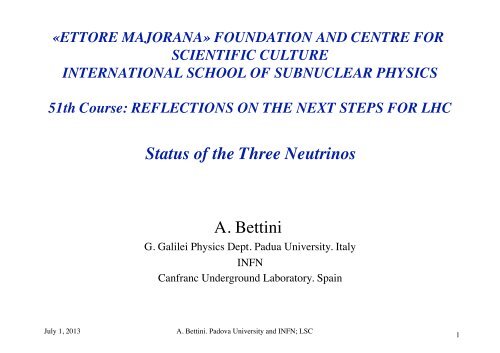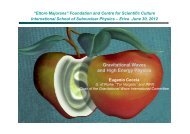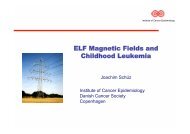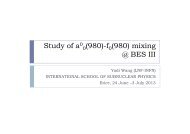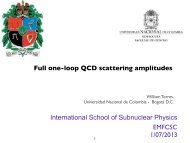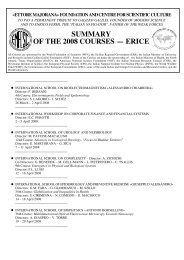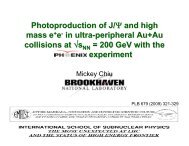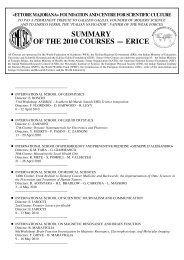You also want an ePaper? Increase the reach of your titles
YUMPU automatically turns print PDFs into web optimized ePapers that Google loves.
«ETTORE MAJORANA» FOUNDATION AND CENTRE FOR<br />
SCIENTIFIC CULTURE<br />
INTERNATIONAL SCHOOL OF SUBNUCLEAR PHYSICS<br />
51th Course: REFLECTIONS ON THE NEXT STEPS FOR LHC<br />
Status of the Three Neutrinos<br />
A. Bettini <br />
G. Galilei Physics Dept. Padua University. Italy<br />
INFN <br />
Canfranc Underground Laboratory. Spain<br />
July 1, 2013<br />
A. Bettini. Padova University and INFN; LSC<br />
1
Three families<br />
The elementary particles come in three “families” with the same structure and distinguished by<br />
the masses of their elements<br />
Each family contains a quark pair and a lepton pair<br />
⎛<br />
⎜<br />
⎝<br />
ν e<br />
e −<br />
The lepton pairs<br />
⎞ ⎛<br />
⎜<br />
⎟ ⎜<br />
⎠ ⎝<br />
ν µ<br />
µ −<br />
⎞ ⎛<br />
⎟<br />
⎟ ⎜<br />
⎠ ⎝<br />
ν τ<br />
τ −<br />
⎞<br />
⎟<br />
⎠<br />
⎛<br />
⎜<br />
⎝<br />
The antilepton pairs<br />
e +<br />
ν e<br />
⎞<br />
⎟<br />
⎠<br />
⎛<br />
⎜<br />
⎜<br />
⎝<br />
µ +<br />
ν µ<br />
⎞<br />
⎟<br />
⎟<br />
⎠<br />
⎛<br />
⎜<br />
⎝<br />
τ +<br />
ν τ<br />
⎞<br />
⎟<br />
⎠<br />
The Standard Model assumes that:<br />
• neutrinos of definite flavour have definite mass (stationary) WRONG<br />
• neutrinos and antineutrinos are distinguished by lepton number NOT PROVEN <br />
• three in number “Anomalies” <br />
Warning. Pieces of “experimental evidence” with < 3σ almost always are later proven<br />
to be wrong, in particular if main uncertainty is systematic<br />
July 1, 2013<br />
A. Bettini. Padova University and INFN; LSC<br />
2
Three neutrinos<br />
LEP <br />
The line shape of the Z becomes wider, and even<br />
more rapidly, lower with increasing neutrinos<br />
numbers<br />
N ν<br />
= 2.984 ± 0.008<br />
Cosmology gives <br />
“effective” neutrino density=density of non interacting<br />
radiation in the early universe. <br />
Prediction of SM = N νeff =3.046 [Mangano et al. hep-ph 0506 164]<br />
Planck + CMB at High L + Polarisation (WP) + Baryon<br />
Acoustic Oscillation (BAO)<br />
+0.54<br />
N ν −eff<br />
= 3.30 −0.51<br />
July 1, 2013<br />
A. Bettini. Padova University and INFN; LSC<br />
3
Neutrino flavours<br />
Definitions<br />
ν e is the neutral particle produced with an e + (e.g. β + decay)<br />
anti ν e is the neutral particle produced with an e – (e.g. β – decay)<br />
ν µ is the neutral particle produced with an µ + <br />
anti ν µ is the neutral particle produced with an µ – <br />
ν τ is the neutral particle produced with an τ +<br />
anti ν τ is the neutral particle produced with an τ + <br />
Neutrinos cannot be directly detected. The charged<br />
lepton produced by the neutrino interaction in the<br />
detector identifies by definition the neutrino flavour<br />
Experimentally. Detection of the charged lepton<br />
flavour without ambiguity is mandatory (NB leptons<br />
are rare)<br />
Question. Is the flavour at detection equal to that at<br />
production <br />
YES, if proper time elapsed is small<br />
July 1, 2013<br />
A. Bettini. Padova University and INFN; LSC<br />
4
Electron and pion showers<br />
Hadrons are produced much more frequently than leptons.<br />
Need discrimination power<br />
electron<br />
The preshower in view of<br />
searching for the third leptonneutrino<br />
sequential doublet<br />
A. Zichichi et al. (At CERN PS<br />
and ADONE)<br />
CERN-63-26. N P Div/ 27:6:1963<br />
Nuov Cim 29 (1965) 464<br />
Main difference<br />
in the “nose”<br />
pion<br />
e/π separation 4 x 10 –4 <br />
Control early shower development with Z<br />
and thicknesses of detector elements <br />
Combine visual and non-visual approaches<br />
(each 10 –2 rejection)<br />
Tracking with thin plate spark chambers<br />
Energy sampling with Pb-scintillator<br />
sandwiches<br />
July 1, 2013<br />
A. Bettini. Padova University and INFN; LSC<br />
5
Electron and pion showers<br />
Zichichi started the search for the 3 rd sequential lepton family, a replica of the first<br />
two, he “Heavy Lepton and its neutrino” at CERN<br />
Searching for acoplanar lepton pairs of opposite charges<br />
ν HL<br />
⎛ ⎞<br />
⎝<br />
⎜ HL⎠<br />
⎟<br />
1967. and later at the ADONE e + e – collider at<br />
Frascati<br />
But maximum energy (3 GeV) was too small<br />
It was found at SLAC with the same method<br />
[M. Bernardini et al. INFN/AE-67/3, 20 March 1967]<br />
July 1, 2013<br />
A. Bettini. Padova University and INFN; LSC<br />
6
Signature of ν µ <br />
muon = long, non interacting track<br />
pion= interacts, if filter is thick enough<br />
electtron = shower<br />
1962. Schwartz, Lederman, Steinberger et al.<br />
discover the µ-neutrino at BNL AGS p accelerator<br />
July 1, 2013<br />
A. Bettini. Padova University and INFN; LSC<br />
7
HL/τ<br />
HL/τ lifetime is short, 0.29 ps O(100 µm) length "<br />
Nagoya Emulsion Cloud Chamber <br />
July 1, 2013<br />
A. Bettini. Padova University and INFN; LSC<br />
8
DONUT. Discovery of ν HL / ν τ <br />
2001. K. Niwa et al. DONUT-E872 at Fermilab <br />
www.fnal.gov/pub/inquiring/physics/neutrino/discovery/photos/signal_low.jpg<br />
www-donut.fnal.gov/web pages/<br />
July 1, 2013<br />
A. Bettini. Padova University and INFN; LSC<br />
9
Neutrino flavour changes<br />
In the last 15 years we learnt that neutrino change flavour, provided time (flight distance) is<br />
given them to do so<br />
Oscillations and flavour conversion in matter, prove that neutrinos, contrary to the<br />
Standard model<br />
• have non-zero mass<br />
• flavour states are superposition (mixing) of mass eigenstates<br />
July 1, 2013<br />
A. Bettini. Padova University and INFN; LSC<br />
10
OPERA nutau appearance candidates<br />
Second ν τ candidate event<br />
July 1, 2013<br />
3 observed events in the τ→h, τ →3h, τ →μ channels<br />
P 0 = 1.13 x 10 –4 <br />
Probability to be explained by background = 7.3 10 –4 <br />
Corresponding to 3.2 σ significance of non-null observation<br />
A. Bettini. Padova University and INFN; LSC<br />
11
Mass eigenstates - Flavour eigenstates<br />
⎛<br />
⎜<br />
⎜<br />
⎜<br />
⎝<br />
ν e<br />
ν µ<br />
ν τ<br />
⎞ ⎛<br />
⎟ ⎜<br />
⎟ = ⎜<br />
⎟ ⎜<br />
⎠ ⎝<br />
1 0 0<br />
0 c 23<br />
s 23<br />
0 –s 23<br />
c 23<br />
⎞⎛<br />
⎟⎜<br />
⎟⎜<br />
⎟⎜<br />
⎠⎝<br />
c 13<br />
0 s 13<br />
e −iδ<br />
0 1 0<br />
–s 13<br />
e iδ 0 c 13<br />
⎞⎛<br />
⎟⎜<br />
⎟⎜<br />
⎟⎜<br />
⎠⎝<br />
c 12<br />
–s 12<br />
0<br />
s 12<br />
c 12<br />
0<br />
0 0 1<br />
⎞⎛<br />
⎟⎜<br />
⎟<br />
⎟⎜<br />
⎠⎝<br />
1 0 0<br />
0 e iφ 1<br />
0<br />
0 0 e iφ 2<br />
if <strong>Majorana</strong><br />
⎞⎛<br />
⎟⎜<br />
⎜<br />
⎟⎜<br />
⎠⎝<br />
ν 1<br />
ν 2<br />
ν 3<br />
⎞<br />
⎟<br />
⎟<br />
⎟<br />
⎠<br />
9 quantities to be measured: 3 masses, 3 angles, 3 phases ⇒ 4.5 known<br />
Define ν 1 , ν 2 , ν 3 in decreasing order of ν e fraction<br />
ν 1 ⇒ ≈ 70% ν e , ν 2 ⇒ ≈ 30% ν e , ν 3 ⇒ ≈ 0% ν e <br />
solar squared mass difference<br />
⇒ δm 2 =m 22 –m<br />
2<br />
1 ( >0 from solar neutrinos)<br />
atmospheric squared mass difference ⇒ Δm 2 =m 32 –(m<br />
2<br />
2 +m<br />
2<br />
1 )/2<br />
July 1, 13<br />
A. Bettini.Padova Univ. and INFN and LSC <br />
12
Neutrino spectrum and mixing<br />
“normal”<br />
“inverted”<br />
We do not know<br />
• The absolute scale<br />
• The sign of Δm 2<br />
• The phases<br />
July 1, 2013<br />
A. Bettini. Padova University and INFN; LSC<br />
13
Neutrino spectrum and mixing<br />
G. L. Fogli et al. 1205.5254<br />
δm 2 = 75.4 ± 2.6 2.2<br />
meV 2 2.6%<br />
Δm 2<br />
= 2430 +70 −90<br />
meV 2 3.5%<br />
sin 2 θ 12<br />
= 0.307 ± 0.017 θ 12<br />
33˚<br />
sin 2 θ 23<br />
= 0.390 ± 0.033 θ 12<br />
39˚<br />
sin 2 θ 13<br />
= 0.0242 ± 0.0026 θ 12<br />
9˚.<br />
July 1, 2013<br />
A. Bettini. Padova University and INFN; LSC<br />
14
Two mechanisms, two class of experiments<br />
Two mechanisms observed changing neutrino flavour<br />
• oscillation in vacuum<br />
• in the kinetic part of the Hamiltonian<br />
• transformation in matter (Mikehev-Smirnov-Wolfestein)<br />
• dynamical phenomenon due to interaction potential between neutrinos and electrons<br />
Two types of experiment<br />
V x<br />
• appearance of a different flavour<br />
• far detector must be sensitive to the new flavour<br />
• disappearance of the initial flavour<br />
• initial flux, composition and spectrum must be accurately known<br />
( ) = 2G F<br />
N e ( x)<br />
July 1, 2013<br />
α ≡ δm2<br />
Δm 2 0.03<br />
θ 2 13<br />
0.024<br />
€<br />
Smallness of two quantities decouples short and long<br />
period oscillations & matter transformations at 1 st order<br />
P( ν x → ν y ,L) = A ν x → ν y<br />
P( ν x<br />
→ ν y<br />
, L) = A ν x<br />
→ ν y<br />
A. Bettini. Padova University and INFN; LSC<br />
( )sin 2 ⎛<br />
⎜ 1.27Δm 2 eV 2<br />
⎝<br />
⎛<br />
( )sin 2 ⎜1.27δm 2 eV 2<br />
⎝<br />
( )<br />
( )<br />
( )<br />
( )<br />
( ) L km<br />
E GeV<br />
( ) L km<br />
E GeV<br />
⎞<br />
⎟<br />
⎠<br />
⎞<br />
⎟<br />
⎠<br />
15
Shorter period oscillation (“atmospheric”)<br />
First order amplitudes<br />
( ) ≈ 1 2<br />
A( ν µ → ν x ) = sin 2 ( 2θ 23 )cos 2 ( θ 13 ) 1− sin 2 θ 23 cos 2 θ 13<br />
Disappearance. Atmospheric<br />
A( ν µ → ν τ ) = sin 2 ( 2θ 23 )cos 4 ( θ 13 ) ≈ 1 Dominant. Appearance. Observed by OPERA @ LNGS<br />
A( ν µ → ν e ) = sin 2 ( θ 23 )sin 2 2<br />
( 2θ 13 ) ≈ 2θ 13<br />
Rare. Appearance. Observed by T2K at Kamioka<br />
A( ν e → ν x ) = sin 2 2<br />
( 2θ 13 ) ≈ 4θ 13<br />
Disappearance. Observed by DayaBay, Reno, DChooz<br />
Longer period oscillation (“solar”)<br />
4<br />
( ) = c 13<br />
P ν e<br />
→ ν e<br />
⎛<br />
⎛<br />
1− sin 2 2θ 12<br />
sin 2 1.27δm 2 L ⎞⎞<br />
⎛<br />
⎜<br />
⎜ ⎟⎟+ s 4 13<br />
1− sin 2 2θ 12<br />
sin 2 1.27δm 2 L ⎞<br />
⎜ ⎟<br />
⎝<br />
⎝ E ⎠⎠<br />
⎝ E ⎠<br />
Amplitudes are different (but PDG still calls all of them sin 2 2θ in some plots)<br />
Vacuum oscillation probabilities do not depend at 1 st order on sign of ∆m 2 and sign of (θ–π/4)<br />
MSW depends on signs<br />
Vacuum oscillations at 2 nd order depend on signs<br />
July 1, 2013<br />
A. Bettini. Padova University and INFN; LSC<br />
16
What next<br />
• Sign of ∆m 2 (mass hierarchy=MH, problem)<br />
• Long base line (O 50 km) reactor<br />
• Atmospheric neutrinos<br />
• Very long (O 1000 km) base line from accelerator<br />
• HyperK in Japan, LAGUNA-LBNO in Europe, LBNE in USA.<br />
• Supernova, with luck<br />
• CP violation in mixing Dirac matrix<br />
• Beam from accelerator<br />
• Energy and baseline can be small (electron appearance)<br />
• Absolute neutrino mass scale<br />
• Beta decays or electron capture<br />
• Cosmology<br />
• Neutrino-less double beta <br />
• Nature of neutrinos <br />
• Neutrino-less double beta<br />
July 1, 2013<br />
A. Bettini. Padova University and INFN; LSC<br />
17
θ 13 from reactor anti-nue disappearance<br />
Six 20 t detectors <br />
Gd loaded Liquid<br />
Scint<br />
July 1, 2013<br />
A. Bettini. Padova University and INFN; LSC<br />
arXiv:1211.0469v3 [hep-ex] 22 Jan 2013<br />
18
T2K θ 13<br />
from accelerator ν µ ν e <br />
10 events<br />
July 1, 2013<br />
A. Bettini. Padova University and INFN; LSC<br />
19
Next on MH Daya Bay 2<br />
( ) 1− sin 2 2θ 12<br />
sin 2 Δ 21<br />
− 4θ 13<br />
P ν e<br />
→ ν e<br />
Δ ≡ 1.27Δm 2 L<br />
E<br />
2<br />
NH Δ 31<br />
2<br />
= Δ 32<br />
2<br />
+ Δ 21<br />
∆E/E < 3% crucial and challanging<br />
2 cos 2 θ 12<br />
sin 2 Δ 31<br />
− 4θ 2 13<br />
sin 2 θ 12<br />
sin 2 Δ 32<br />
2<br />
IH Δ 31<br />
2<br />
= Δ 32<br />
2<br />
− Δ 21<br />
S.T. Petcov et al., PLB533(2002)94; S.Choubey et al., PRD68(2003)113006; J. . Learned et al., hep-ex/0612022<br />
L. Zhan, Y. Wang, J. Cao, L. Wen, PRD78:111103, 2008 PRD79:073007, 2009 <br />
July 1, 2013<br />
A. Bettini. Padova University and INFN; LSC<br />
20
Daya Bay 2 Possible sites<br />
60 km<br />
July 1, 2013<br />
A. Bettini. Padova University and INFN; LSC<br />
21
Next on MH India based Neutrino Observatory<br />
Originally proposed by MONOLITH (LNGS P26/2000)<br />
P( ν µ<br />
→ ν µ ) ≠ P( ν µ<br />
→ ν µ )<br />
The surviving probabilities differ due to<br />
opposite matter potential (subdominat effect)<br />
Effect depends on sign of ∆m 2 13 <br />
Effect most important at MSW resonance<br />
Magnetized Fe tracking calorimeter<br />
Compare Down/Up vs. Zenith angle<br />
Mass= 50 kt; B=1.3 T;<br />
Momentum resolution is crucial<br />
Sensitivity to MH: 2 σ in 5 yr, 2.7 σ in 10 years (or doubling the mass, about 130 M€)<br />
July 1, 2013<br />
A. Bettini. Padova University and INFN; LSC<br />
22
CP phase<br />
The disappearance probability is the complement to 1<br />
of remaining with the original flavour, consequently it is<br />
independent on the sign of time. CPT consequently<br />
implies independence on CP phase<br />
P( ν e<br />
→ ν e ) 1− sin 2 2θ 12<br />
sin 2 1.27Δm 2 L<br />
E<br />
Electron neutrino appearance on a muon neutrino beam. In vacuum<br />
2<br />
Δ ≡ Δm 31<br />
Δm 2 21<br />
= αΔ = 0.03Δ Δm 2 32<br />
= ( 1−α)Δ<br />
( ) = P 0<br />
+ P sinδ<br />
+ P cosδ<br />
+ P 3<br />
P ν µ<br />
→ ν e<br />
⎛<br />
P 0<br />
= sin 2 θ 23<br />
sin 2 2θ 13<br />
sin 2 1.27Δ L ⎞<br />
⎜ ⎟<br />
⎝ E ⎠<br />
⎛<br />
P sinδ<br />
= α × sinδ × cosθ 13<br />
× sin 2θ 12<br />
× sin 2θ 23<br />
× sin 2θ 13<br />
× sin 3 1.27Δ L ⎞<br />
⎜ ⎟ opposite sign for antineutr.<br />
⎝ E ⎠<br />
⎛<br />
P cosδ<br />
= α × cosδ × cosθ 13<br />
× sin 2θ 12<br />
× sin 2θ 23<br />
× sin 2θ 13<br />
× cos⎜1.27Δ L ⎞ ⎛<br />
⎟sin 2<br />
⎜1.27Δ L ⎞<br />
⎟<br />
⎝ E ⎠ ⎝ E ⎠<br />
⎛<br />
P 3<br />
= α 2 cos 2 θ 23<br />
sin 2 2θ 12<br />
sin 2 1.27Δ L ⎞<br />
⎜ ⎟<br />
⎝ E ⎠<br />
Matter is not CP symmetric. Matter effects give additional dependence on flight<br />
length and matter density.<br />
M. Freund arXiv:hep-ph/0103300v1 28 Mar 2001<br />
July 1, 2013<br />
A. Bettini. Padova University and INFN; LSC<br />
23
CP Phase<br />
T2K appearance PRL 107, 041801 (2011)<br />
T2K programme<br />
We shall learn a lot in the coming years!<br />
DayaBay & RENO disappearance<br />
July 1, 2013<br />
A. Bettini. Padova University and INFN; LSC<br />
24
CP Phase. NOνA FermiLab<br />
see. C. Backhouse<br />
Expected to start now<br />
2.5 kt mass<br />
300 kW on target<br />
ramp to 14kt, 700 kW<br />
sensitive to δ CP and MH<br />
810 km<br />
We shall learn a lot in the coming years!<br />
14 kt mass<br />
modular<br />
July 1, 2013<br />
A. Bettini. Padova University and INFN; LSC<br />
25
More than three<br />
Reactor antineutrino anomaly<br />
2011. Th. A. Mueller et al. [Phys. Rev., C83:054615] re-evaluation of the reactor antineutrino flux.<br />
Up by 3%, with a systematic uncertainty of >2.7%<br />
2011. G. Mention et al.[ Phys. Rev., D83:073006]: the average of the measured flux at distances <<br />
100 m accounts for only 0.943 ± 0.023 (2.5 σ). Claim evidence for sterile neutrino (!!)<br />
2013. C. Zhang et al. [Phys. Rev. D 87, 073018]. Now θ 13 is known. Calculate flux at the distances of<br />
the measurements. Extrapolate to 0 distance. <br />
0.959 ± 0.009 (exp) ± 0.027(syst) of the Mueller re-evaluation; difference is 1.4 σ<br />
No anomaly <br />
July 1, 2013<br />
A. Bettini. Padova University and INFN; LSC<br />
26
More than three<br />
Gallium anomaly<br />
Both GALLEX/GNO and SAGE performed two runs each with radioactive neutrino sources<br />
for checking the overall extraction efficiency<br />
Averaging (!) the four ratios found/expected one finds R=0.86±0.05<br />
Neither experiment used R to calibrate due to due to the uncertainties in the <br />
ν e + 71 Ga 71 Ge+e – (detector) and e – + 51 Cr 51 V+ν e (source) cross sections<br />
To be tested by Borexino + source<br />
LSND & MiniBoonE<br />
LSND (1995) observed a 3.8 σ excess in anti ν µ anti ν e . If oscillation ∆m 2 >0.2 eV 2 .<br />
Effect based on a background model <br />
KARMEN (2001) excluded almost all the LSND parameter space<br />
MiniBooNE (2007-9). ν µ ν e . Higher E, same L/E. NO signal @ LSND claim. Excess at low<br />
energies, where background model is most uncertain, not compatible with oscillations<br />
MiniBoone (2010) anti ν µ anti ν e claims signal in oscillation region observing excess of<br />
20.9±14.0 events<br />
2012 Kyoto conference. Chris Polly: Higher stat anti-nu data is now much more consistent with<br />
neutrino data (excess at low energy). It is not yet known whether the excesses are due to<br />
oscillations, some unrecognized NC γ background, or something else<br />
July 1, 2013<br />
A. Bettini. Padova University and INFN; LSC<br />
27
Exclusion OPERA & ICARUS<br />
CNGS exclusion<br />
MiniBooNe claim excluded at 1 sigma<br />
MiniBooNEarXiv:1207.4809v2<br />
OPERA arXiv:1303.3953<br />
ICARUS arXiv:1209.0122<br />
A. Bettini.<br />
28
Dirac or <strong>Majorana</strong><br />
July 1, 2013<br />
A. Bettini. Padova University and INFN; LSC<br />
29
1937 Nuovo Cimento 14 171-184<br />
We show that it is possible to achieve complete formal symmetrisation in the electron and<br />
positron quantum theory by means of a new quantization process. The meaning of Dirac<br />
equations is somewhat modified and it is no more necessary to speak of negative-energy<br />
states; nor to assume, for any other type of particles, especially neutral ones, the existence<br />
of antiparticles, corresponding to the “holes” of negative energy.<br />
July 1, 13<br />
A. Bettini. INFN and LSC<br />
30
Completely neutral fermions<br />
The new approach allows to “not only to give a symmetric form to the electron-positron theory,<br />
but also to build a substantially novel theory for the particles deprived of electric charge<br />
(neutrons and hypothetical neutrinos)”<br />
…….it is probably “not yet possible to ask to the experience to decide between this new theory<br />
and the simple extension of the Dirac equations to the neutral particles” <br />
<strong>Majorana</strong>, putting the question of complete neutrality, implicitly introduced the notion of<br />
charges different from the electric one<br />
1937 Nuov. Cim. 14 323. Racah. If neutrinos obey Dirac equation,<br />
neutrinos emitted in a β – decay can induce only a β + process and<br />
vice versa<br />
If they obey <strong>Majorana</strong> equation, any neutrino can produce both<br />
electrons and positrons<br />
1939 Phys Rev 56 1184 . Furry. If neutrinos obey <strong>Majorana</strong> double<br />
beta decay can happen without emission of neutrinos (0νββ). The<br />
transition probability should be “much larger” than for the decay<br />
with two neutrinos (2νββ)<br />
Unfortunately it is instead much smaller because CC weak current is<br />
V-A and neutrino masses are small<br />
July 1, 13<br />
A. Bettini. INFN and LSC<br />
31
The bi-spinor<br />
ψ ( x) =<br />
<strong>Majorana</strong> equation<br />
⎛<br />
⎜<br />
⎜<br />
⎜<br />
⎜<br />
ψ 1<br />
ψ 2<br />
ψ 3<br />
ψ 4<br />
⎞<br />
⎟<br />
⎟<br />
⎟<br />
⎟<br />
⎛<br />
= ϕ ⎞<br />
⎝<br />
⎜ χ⎠<br />
⎟ ; ϕ = ⎛ ϕ 1 ⎞<br />
⎝<br />
⎜<br />
⎠<br />
⎟ ; χ = ⎛ χ 1 ⎞<br />
⎝<br />
⎜<br />
⎠<br />
⎟<br />
⎝ ⎠<br />
Question: is it possible to find a spinor Φ constructed with the components of ϕ only (and<br />
hence without further degrees of freedom), which transforms like a χ instead than a ϕ<br />
and that can consequently take its place in the Dirac equation And similarly a spinor X<br />
transforming like a ϕ<br />
The answer, found by <strong>Majorana</strong>, is<br />
*<br />
Φ = iσ 2<br />
χ M<br />
⎛<br />
iσ 2<br />
= 0 1 ⎞<br />
⎝<br />
⎜ −1 0⎠<br />
⎟<br />
ϕ 2<br />
Χ = iσ 2<br />
ϕ M<br />
*<br />
χ 2<br />
In the Dirac theory the ϕ and<br />
χ components have different<br />
transformation properties<br />
Dirac equation<br />
( E + p ⋅σ<br />
) χ − mϕ = 0<br />
( E − p ⋅σ<br />
)ϕ − mχ = 0<br />
<strong>Majorana</strong> equation<br />
( E + p ⋅σ<br />
) χ − im a<br />
σ 2<br />
χ* = 0<br />
( E − p ⋅σ<br />
)ϕ − im b<br />
σ 2<br />
ϕ* = 0<br />
• <strong>Majorana</strong> equations are decoupled, one for ϕ and one for χ spinor (possibly two masses)<br />
• If m=0, Dirac equation = <strong>Majorana</strong> equation<br />
• Charge conjugation transforms <strong>Majorana</strong> field into itself<br />
July 1, 13<br />
A. Bettini. INFN and LSC<br />
32
Chirality<br />
Chirality is a property of the 4-component bispinor<br />
The states of definite chirality are the eigenstates of γ 5 , called L for the eigenvalue –1, R<br />
for +1<br />
Neutrino field has negative chirality. Neutrinos and antineutrinos are left<br />
ψ L = 1 (<br />
2 1− γ 5)ψ, γ 5 ψ L = −ψ L<br />
ψ R = 1 (<br />
2 1+γ 5)ψ, γ 5 ψ R = +ψ R<br />
γ 5 commutes with the Hamiltonian of free massless Dirac particles (not existing in Nature), <br />
€<br />
γ 5 does not commute with the mass term of the Dirac Hamiltonian<br />
Chirality is not an observable, we measure helicity instead<br />
July 1, 13<br />
A. Bettini. INFN and LSC<br />
33
The fields of definite chirality are<br />
Chirality and helicity<br />
ψ L<br />
= 1 2 1− γ ⎛<br />
( 5 )ψ = 0 0 ⎞ ⎛ϕ⎞<br />
⎝<br />
⎜ 0 1⎠<br />
⎟<br />
⎝<br />
⎜ χ⎠<br />
⎟ =<br />
⎛<br />
⎝<br />
⎜<br />
0 ⎞<br />
χ⎠<br />
⎟ ψ = 1 R<br />
2 1+ γ ⎛<br />
( 5 )ψ = 0 1 ⎞ ⎛ϕ⎞<br />
⎝<br />
⎜ 0 0⎠<br />
⎟<br />
⎝<br />
⎜ χ⎠<br />
⎟ = ⎛ ϕ ⎞<br />
⎝<br />
⎜ 0⎠<br />
⎟<br />
Neutrinos = those produced in β + decays, are created and destroyed by the spinor φ<br />
Antineutrinos = those produced in β + decays, are created and destroyed by the spinor χ<br />
Both are left<br />
Both have positive (+) and negative (–) helicity components<br />
For E>>m <br />
ϕ = ν ≈ m E ν + −<br />
L<br />
+ν L<br />
χ = ν ≈ ν + L<br />
+ m E ν −<br />
L<br />
If m=0 neutrinos are pure h=– states, antineutrinos pure h=+ states<br />
But m≠0 and E>>m, then neutrinos have a small (m/E) “wrong” helicity component<br />
If <strong>Majorana</strong>, “neutrino” is the state with h=–1; “antineutrino” is the state with h=+1<br />
July 1, 13<br />
A. Bettini. INFN and LSC<br />
34
<strong>Majorana</strong> vs Dirac at relativistic energies<br />
m/E ν
ββ0ν Decay<br />
<strong>Majorana</strong> neutrino couples to W exactly<br />
as Dirac neutrino<br />
The SM violation is in the propagator<br />
The status created at one vertex has definite flavour,<br />
hence is a superposition of mass eigenstates<br />
Mass eigenstates do not have definite helicity, are<br />
superpositions of <strong>Majorana</strong> neutrinos and antineutrinos<br />
At one vertex the antineutrino component matters, the<br />
neutrino component at the other vertex<br />
ν e<br />
=U e1<br />
ν 1<br />
+U e2<br />
ν 2<br />
+U e3<br />
ν 3<br />
ν i<br />
≈ m i<br />
E ν + −<br />
iL<br />
+ν iL<br />
M ee<br />
=|<br />
∑<br />
i<br />
2<br />
U ei<br />
m i<br />
|≈ 0.67m 1<br />
+ 0.30m 2<br />
e i2α i2( β−δ)<br />
+ 0.03m 3<br />
e<br />
July 1, 2013<br />
A. Bettini. Padova University and INFN; LSC<br />
36
Experimental challenges<br />
Experiments measure the sum energy of the two electrons<br />
If background index b, sensitive mass M, live time T and energy resolution ΔE<br />
1<br />
sensitivity to<br />
M<br />
M ∝ F = ⎛<br />
ε i.a. ⎞<br />
1/2<br />
⎛ MT ⎞<br />
1/4<br />
M ⎜ ⎟ ⎜ ⎟<br />
ee<br />
⎝ A ⎠ ⎝bΔE<br />
⎠<br />
If b=0 during T, in an energy window<br />
of about ΔE sensitivity to M ee <br />
F M<br />
∝ε i.a.<br />
A<br />
2<br />
MT<br />
Energy resolution and almost zero<br />
background are the key factors<br />
July 1, 13<br />
A. Bettini. INFN and LSC<br />
37
M ee<br />
=| ∑U 2<br />
ei<br />
m i<br />
|=| c 13<br />
i<br />
2 c 12<br />
2 m 1<br />
+ c 13<br />
Mee vs ligthest<br />
2 s 12<br />
≈ 0.83m 1<br />
+ 0.55m 2<br />
e iφ 2 + 0.15m 3 eiφ 3<br />
2 m 2<br />
e iφ 2 + s 2 13m 3<br />
e iφ 3 |≈<br />
1/T 1/2 = G(Q,Z) |M nucl | 2 M ee2 <br />
Phase<br />
Space<br />
N. M. E.<br />
“Effective”<br />
<strong>Majorana</strong> mass<br />
Bilenki & Giunti arXiv 1203.5250<br />
A. Bettini.<br />
38
0νββ running (or close to) experiments<br />
For M ee =100 meV expect τ = 1 - 4 × 10 26 yr. <br />
For 1 k mol mass (6 × 10 26 nuclei) expect few events per year<br />
Numbers of signal events @ 100 meV and background for a k mole yr exposure<br />
Red figures are expected values<br />
76<br />
Ge 136 Xe 136 Xe 136 Xe 130 Te <br />
GERDA1/2 EXO200 KL-ZEN NEXT CUORE<br />
signal 1.6 3.8 3.8 3.8 5.5<br />
b/ (keV kg yr)/10 –3 20/1.2 1.4 5 0.5 29<br />
ΔE (keV) 4 97 243 20 5<br />
background in ∆E 6/0.4 18 243 1.3 14.5<br />
Isotope mass (k mol) 0.2/0.5 0.65 1.06 0.7 15.8<br />
Present generation of experiments will reach 100 meV improving BI<br />
Monolithic detectors (liquid or gas) have better scalability <br />
Self-shielding with the isotope (EXO) is expensive<br />
Avoid surfaces near source (KL-ZEN)<br />
July 1, 2013<br />
A. Bettini. Padova University and INFN; LSC<br />
39
EXO200<br />
Observed 1.6 ×10 25 yr @ 90% c.l.<br />
A. Bettini.<br />
40
KamLAND-ZEN<br />
Assuming background<br />
model being correct<br />
Q ββ = 2457.83±0.37 keV<br />
Exposure 89.5 kg yr of 136 Xe<br />
ΔE FWHM /E = 9%<br />
b= 1.2 10 –1 cts/(kg keV yr) <br />
0ν<br />
T 136 1/2 ( Xe) >1.9 ×10 25 yr @ 90% c.l.<br />
A. Bettini.<br />
41
GERDA @ LNGS<br />
K.H. Ackermann et al. Eur. Phys. J. C 73 (2013) 908 2330<br />
A. Bettini.<br />
42
0ν<br />
T 1/2<br />
GERDA 1<br />
Exposure almost 22 kg yr<br />
Background model(s) developed with blinded interval of ±20 keV around Q ββ = 2039 keV<br />
Between “minimum” and “maximum” (shown) components to explain yhe observed spectrum<br />
Then partially unblind but ±5 keV around Q ββ to check<br />
Number of observed events consistent with predictions<br />
No line predicted near Q ββ <br />
BI, before PSA, predicted at for the coaxial detectors at Q ββ<br />
Sensitivity, before PSA<br />
( 76 Ge) > 1.7 Bayesian<br />
( ) −1.9 likelhood<br />
BI =1.75 +0.26 −0.24<br />
×10 −2 cts/(keV kg yr)<br />
( )×10 25 yr @ 90% c.l.<br />
arXiv:submit/0743056 [hep-ex] 20 Jun 2013 Submitted to EPJC<br />
A. Bettini.<br />
43
Energy resolution target: FWHM = 1% @ Q ββ <br />
Exploiting<br />
ElectroLuminescence read out<br />
NEXT<br />
100 kg 136 Xe high pressure TPC<br />
BI 5x10 –4 /(keV kg yr)<br />
Exploiting<br />
transparency<br />
topological signature<br />
Simulation<br />
A. Bettini.<br />
44
NEXT. Data from prototypes<br />
Energy resolution<br />
FWHM = 0.75% @ Q bb<br />
measured in prototypes<br />
22<br />
Na 511 keV γ <br />
Electron track 600 keV γ source<br />
A. Bettini.<br />
45
SNO+<br />
1 yr, 500 kg Nd, M ee = 150 meV (now decided for Te)<br />
B=2 10 –2 dominated by 2ν2β tail<br />
A. Bettini.<br />
46
Present generation sensitivities<br />
Gomez Cadenas et al. “The search for neutrinoless double beta decay”<br />
Riv. Nuovo Cimento 2012<br />
July 1, 13<br />
A. Bettini.Padova Univ. and INFN and LSC <br />
47
Conclusions<br />
• Neutrino physics has opened the first window beyond the Standard Model<br />
• since the discovery of the solar neutrino puzzle almost 50 years ago<br />
• Neutrino physics has made tremendous progress in the last 20 years using<br />
• different powerful sources: Sun, cosmic rays, reactors, accelerator beams<br />
• different detector techniques: low background techniques, radiochemical<br />
detection, criogenic calorimeters, large mass (Cherenkov) detectors,<br />
tacking detectors, etc<br />
• underground, surface, space laboratories<br />
• We measured the absolute value of the mixing elements, but not its phases<br />
• CP violation in the neutrino sector might be able to explain the matterantimatter<br />
asymmetry in the Universe<br />
• We measured the mass differences, but not one of the signs neither the<br />
absolute mass scale<br />
• We do not know if neutrinos and antineutrinos are different particles or not<br />
• Next phases of neutrino physics will be demanding<br />
• Resources are limited, their use should be optimised with the aim to<br />
maximize the scientific output, in a globally co-ordinated programme<br />
July 1, 13<br />
A. Bettini.Padova Univ. and INFN and LSC <br />
48
THANK YOU<br />
July 1, 2013<br />
A. Bettini. Padova University and INFN; LSC<br />
49


